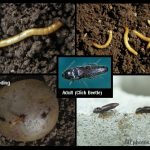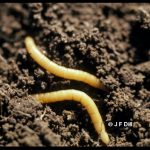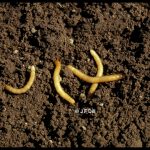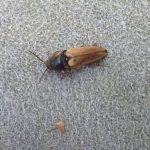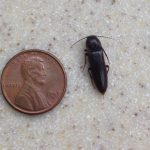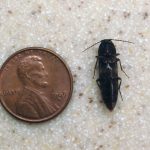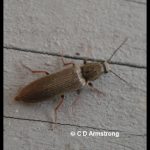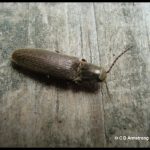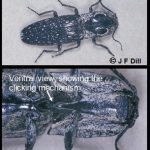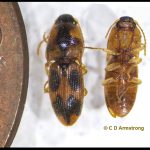Click Beetles
Click beetles are ‘famous’ for their clicking mechanism that they possess. They belong to the family of beetles called Elateridae, all of whose members can ‘click,’ which, although it is used primarily as a defense to escape from or to startle a potential predator, it is also very useful in ‘righting’ itself whenever the beetle gets turned onto its back.
Most click beetles are rather small in size and dull in color. They are generally nocturnal and plant-eating, and usually of no economic significance as adults [some species of click beetle larvae, however, called wireworms, are serious agricultural pests that attack many vegetables including potatoes, onions, corn, carrots, peas, beans and melons.]
Wireworms, which resemble mealworms, are cylindrical, about 1-1/2 inches long, brownish to yellow and are rather hard-bodied (see photos below). Although some species complete their development in one year (e.g. Conoderus), wireworms usually spend three or four years in the soil before becoming adults.
In hot weather, click beetles will often enter people’s houses at night through open windows and doors (they are attracted to lights), making them somewhat of a nuisance.
- Click Beetle images (larvae and adults)
- Wireworm (additional example)
- Wireworms (Larval stage of beetles called Click Beetles)
- Wireworms (Click Beetle larvae)
- Click Beetle
- Click Beetle (dorsal view)
- Click Beetle (ventral view) — June, 2018; Dixmont, ME
- Click beetle
- Click Beetle
- Click beetle called “Eyed Elater”
- Flat Wireworm / Sweet Click Beetles (Aeolus mellillus) (Bangor, ME; 10/11/2023) (dorsal and ventral views, beside a US penny)
Additional Information:
- Click Beetles (Texas A&M)
- Eyed Click Beetle (Eyed Elater) (Texas A&M AgriLife Extension Service)
- Wireworms (part of our “Soil Insect Pests of Vegetables” publication) (UMaine Extension)
- Wireworms (part of UMaine Extension’s Potato IPM Program)

